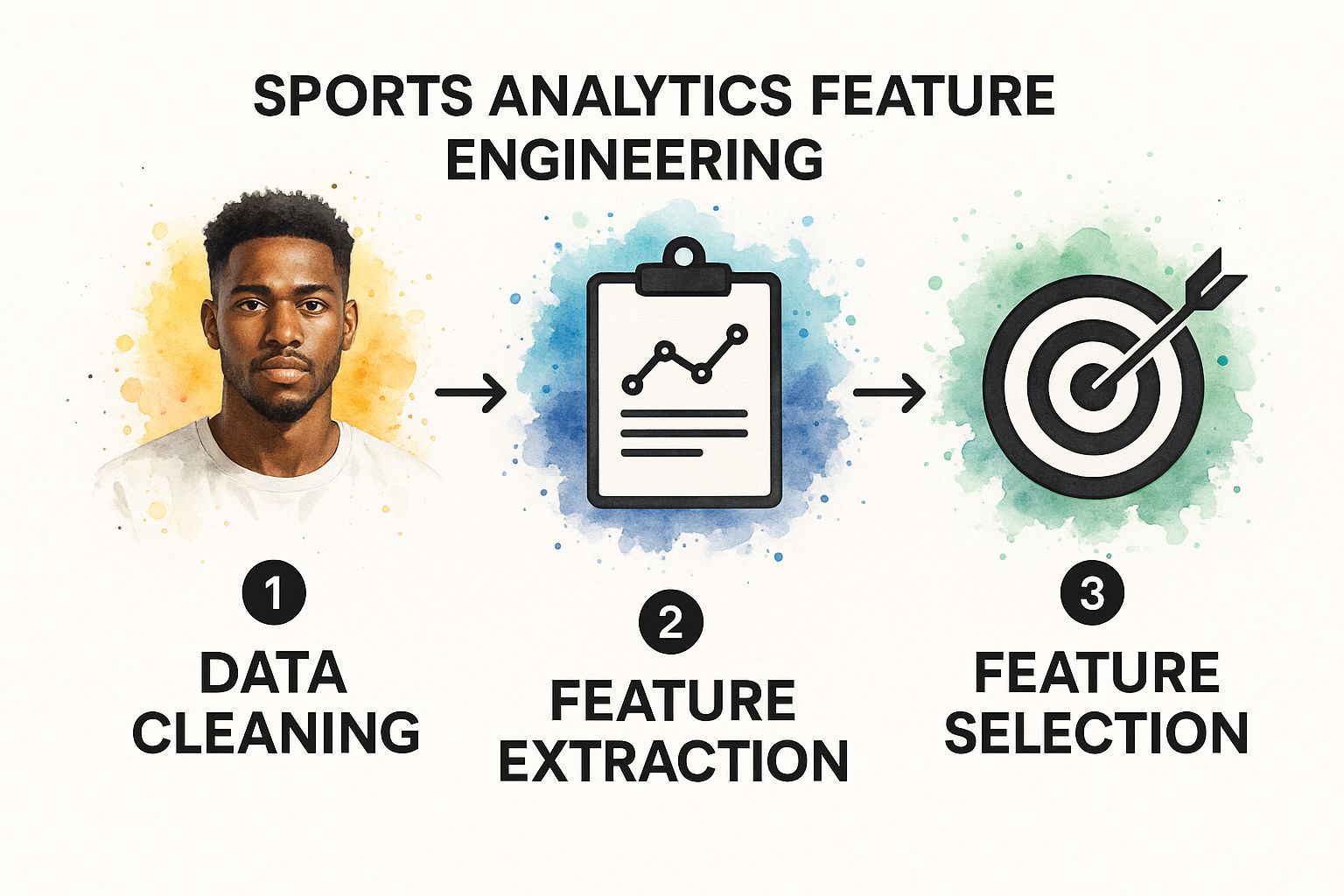
Machine Learning Sports Analytics A New Playbook
When you hear "sports analytics," you might think of basic stats like batting averages or points per game. But machine learning is taking things to a whole different level. It's not just about what happened; it's about predicting what's going to happen.
This isn't just about crunching numbers. We're talking about using historical data to find hidden patterns that can forecast player performance, fine-tune team strategies, and even flag potential injuries before they sideline a key player.
How Machine Learning Is Redefining Sports

Think of data as the most valuable player on any team right now. This guide will break down the world of machine learning in sports analytics in a way that’s easy to get, whether you're a lifelong fan or an aspiring data scientist.
Here’s a good way to think about it: A rookie quarterback spends hours watching game film to learn how to read defensive formations. Machine learning models do something similar, but they sift through mountains of game data to spot incredibly subtle patterns that are almost impossible for a human eye to catch.
Moving Beyond Basic Statistics
For decades, sports analysis was stuck with simple box-score stats. They were useful, sure, but they only told you the story of what already happened. Machine learning flips the script from descriptive to predictive.
So, instead of just knowing a striker scored 20 goals last season, analytics can now forecast how likely they are to score against a specific defensive lineup. That kind of insight changes the game completely.
This is a fast-growing field, and it's creating thousands of jobs for analysts, engineers, and data scientists. If you're looking to break into this exciting industry, you can check out www.sportsjobs.online to see the latest openings with top teams and companies.
The real magic of machine learning in sports is its ability to answer complex "what if" questions. What if we sub in this player right now? What’s the best play to call in this exact situation? The answers are now backed by data, not just a coach's gut feeling.
A Fundamental Shift in the Game
This technology isn't just another fancy tool; it represents a fundamental change in how sports are played, managed, and even watched. By uncovering the hidden drivers of performance, it gives the front office a real competitive edge.
Here’s a quick look at how machine learning is already making a huge impact:
- Smarter Scouting: Teams can find undervalued players whose underlying metrics scream "high potential." It's like the "Moneyball" concept, but supercharged with AI.
- Tactical Optimization: Coaches get data-driven suggestions on everything from in-game substitutions to the most effective plays against a specific opponent.
- Injury Prevention: By analyzing data from wearable sensors that track player workload and biometrics, teams can predict and prevent injuries, keeping their stars on the field and off the IR.
- Enhanced Fan Engagement: Leagues and broadcasters use analytics to create more compelling content, offering deeper insights and predictive graphics during live games that fans love.
This guide will walk you through the key concepts, the data pipelines, and the real-world applications that are driving this shift. Get ready to see the game from a whole new angle.
Understanding the Core Concepts in Sports Analytics

To really get a feel for how machine learning works in sports analytics, you need to wrap your head around a few key ideas. Don't worry, it’s not about diving into complex math right away. It's more about understanding the logic of how a computer actually learns from game data.
Let's break down the essential terms using some simple sports analogies. At its core, machine learning is split into two main philosophies: supervised and unsupervised learning. Thinking about them in a practical, on-the-field context makes them much easier to grasp.
Supervised vs Unsupervised Learning
Think of supervised learning as a coach teaching a specific, targeted skill. Picture a soccer coach showing a player exactly how to curl a free kick around a defensive wall. The coach provides examples of successful kicks (the data) and defines the desired outcome (a goal). The player just keeps practicing until they can nail it consistently.
In analytics, the machine learning model is the player. You feed it labeled data, maybe thousands of past plays marked as "turnover" or "touchdown", and it learns to spot the patterns that lead to one outcome or the other.
Unsupervised learning, on the other hand, is like letting a creative player just mess around in practice with no specific instructions. The coach isn't telling them what to do. By just experimenting, the player might invent a new dribbling move or discover a clever passing angle on their own. They're finding valuable patterns without being told what to look for.
An algorithm using this approach could sift through player-tracking data from an entire league and group players into clusters based on their movement patterns. This could uncover distinct player types that scouts had never even thought to look for.
The key difference is the "teacher." Supervised learning uses labeled data to predict a known outcome. Unsupervised learning explores unlabeled data to discover hidden structures all on its own.
Features and Labels: The Building Blocks of Models
Two other terms you'll hear all the time are features and labels. These are the absolute fundamentals for most supervised learning models.
Imagine you're analyzing a basketball player. Their features are their individual stats and attributes, the raw numbers that describe them.
- Height and wingspan
- Points per game
- Three-point shooting percentage
- Rebounds and assists
- Average speed on the court
The label is the specific outcome you’re trying to predict. For instance, the label could be a simple binary: will the player's team win or lose their next game? The model crunches all the features to figure out how they connect to that final label.
This is exactly what professionals do. Roles like a business and data strategy analyst for an MLS team are all about turning these very concepts into winning strategies on the field.
By understanding these basics, you can start to see the whole picture. Machine learning in sports analytics is all about translating the game into a language computers can work with, finding the hidden patterns, and using those insights to make smarter, data-driven decisions.
The Data Pipeline: From Raw Numbers to Winning Insights
Let's be honest, raw data is pretty much useless. On its own, it’s just a giant, messy pile of numbers and text entries. The real magic in machine learning sports analytics happens when we take that raw data and turn it into something a team can actually use. This entire process is what we call the data pipeline.
Think of it like a master chef getting ready for a dinner service. A cart full of raw ingredients isn't a gourmet meal. Each vegetable needs to be washed and chopped, every protein seasoned, and everything cooked in a specific order. A data pipeline does the exact same thing for sports data, transforming it from a jumble of numbers into actionable, game-winning insights.
This structured process is everything. Without a clean, well-oiled pipeline, any analysis you build will be on a shaky foundation. It’s the classic "garbage in, garbage out" problem, and it will sink your project before it even starts.
Let’s walk through how it all comes together, step by step.
Getting the Right Ingredients: Data Acquisition and Cleaning
The journey always kicks off with data acquisition. This is where we gather all the information from a massive range of sources.
- Wearable Technology: Think GPS trackers and biometric sensors on players. These devices pull in data on speed, total distance covered, heart rate, and acceleration patterns.
- Video Tracking Systems: High-tech cameras installed in stadiums are constantly capturing the precise coordinates of every player and the ball, multiple times a second.
- Traditional Statistics: Your classic play-by-play logs, box scores, and historical stats provide the foundational context for everything else.
Once we have it all, the data is almost always messy. You'll find missing values, typos, and all sorts of inconsistencies. The next critical step is data cleaning, which is all about tidying things up. This means fixing errors, intelligently filling in gaps, and standardizing formats to make sure the data is reliable and ready for the next stage.
If you’re serious about building a career in this space, getting your hands dirty with the data pipeline is non-negotiable. When you're ready to start looking for your next role, it's worth checking out the latest opportunities on www.sportsjobs.online.
A solid data pipeline involves several key stages, each with a distinct purpose. Here’s a quick breakdown of what a typical workflow looks like.
| Stage | Purpose | Example Activities |
|---|---|---|
| Data Acquisition | To collect raw data from various sources. | Pulling data from GPS trackers, stadium cameras, and historical databases. |
| Data Cleaning | To fix errors and inconsistencies for reliable analysis. | Handling missing values, correcting typos, and standardizing units (e.g., feet to meters). |
| Feature Engineering | To create new, more insightful variables from existing data. | Combining speed and heart rate to create a 'fatigue score'. |
| Feature Selection | To identify and select the most predictive features. | Using statistical tests to determine which features have the biggest impact on the outcome. |
| Model Training | To teach the machine learning model patterns in the data. | Feeding the prepared data into a regression or classification algorithm. |
| Model Evaluation | To test the model's performance and accuracy. | Using a separate test dataset to see how well the model makes predictions on unseen data. |
Each step builds on the last, systematically refining the raw information until it’s ready to produce powerful insights.
Adding the Secret Sauce: Feature Engineering
With clean data in hand, the real creativity begins with feature engineering. This is where data scientists and analysts create new, more meaningful metrics from the data we already have. Instead of just looking at a player's top speed, an analyst might combine that with acceleration and heart rate data to engineer a custom 'player fatigue index.'
This stage is what separates basic reporting from true predictive power. It helps the machine learning model see the subtle nuances of the game, the things that aren't obvious from just looking at the raw numbers. The flow from raw data to a refined feature set is a core part of the process.

As the infographic shows, it’s a funnel. You start with messy raw data, clean it up, create new features, and then filter down to only the most impactful ones for your model. This refinement is what truly drives powerful, predictive analytics.
The goal of a data pipeline isn't just to process data. It’s to prepare it in a way that tells a story. Each step adds a new layer of context, turning simple numbers into a powerful narrative that can inform high-stakes decisions.
The demand for these skills is exploding. The global sports analytics market is on track to jump from around $6 billion in 2025 to over $36.2 billion by 2035. This isn't just a trend; it's a fundamental shift in how the sports world operates, from player scouting to fan engagement. Leagues like the NFL and NBA in North America are leading the charge. You can dig into the numbers and learn more about the growing sports analytics market.
Ultimately, every single step in this pipeline, from collection to cleaning to feature engineering, serves the grand finale: model training. This is where we finally feed our beautifully prepared data into a machine learning algorithm, letting it learn the hidden patterns that will give a team its next competitive edge.
Choosing the Right Algorithms for the Job

Okay, so your data is clean and prepped. Now comes the big decision: which machine learning algorithm do you actually use?
Think of it like a mechanic standing in front of a giant toolbox. You wouldn't grab a hammer to change a tire, and you wouldn't use a socket wrench to drive a nail. Every tool has a purpose. It's the same in machine learning sports analytics, your algorithms are your specialized tools.
Picking the right one is absolutely critical for getting the answer you're looking for. Some models are fantastic for predicting numbers, others excel at sorting things into buckets, and some are built to find natural, hidden patterns in your data.
This isn't about finding one "best" algorithm. It's about matching the right tool to the right question. Let's break down the main types you'll run into.
Regression for Predicting the Future
When your goal is to predict a specific number, you’ll turn to regression models. These algorithms are your go-to for forecasting continuous values, like a player's future stats or a team's expected ticket sales for the season.
A classic example is using linear regression to project how many points a basketball player might score next season. The model looks at historical data, things like their age, minutes played, and past scoring averages, to come up with a predictive formula.
- Linear Regression: Perfect for simple, direct relationships. Think predicting a quarterback's passing yards based on their completion percentage.
- Ridge and Lasso Regression: These are souped-up versions that help prevent a model from getting too complex and making wild, inaccurate predictions on new data.
Classification for Making Decisions
But what if your question is more of a "yes or no" situation? That's where classification models come in. These algorithms are built to predict a category or class, not a number.
A common use case is predicting the outcome of a game: will a team win or lose? Another huge one is injury prediction, figuring out if a player is at high risk or low risk based on workload data from their wearable sensors.
The output of a classification model is a probability. It might tell you there's an 85% chance of winning the game if you use a certain strategy, giving coaches a data-backed reason to make a tough call.
If you love the strategic thinking behind this stuff, you're thinking like the top data scientists in sports. A role like a Senior Data Scientist involves choosing and fine-tuning these very algorithms to give a team its competitive edge.
Clustering for Finding Hidden Groups
Sometimes, you don't even have a specific outcome to predict. You just want to explore your data and see what natural patterns or groups emerge. This is where clustering algorithms absolutely shine.
Clustering is what we call an "unsupervised" learning method. You don't feed it labeled data with the "right" answers. You just hand it a pile of player stats, and it does the work of grouping similar players together.
For instance, an NBA team could use clustering on player-tracking data to identify different types of defenders. It might uncover a group of "perimeter lockdowns" and another of "rim protectors," helping scouts find the exact player archetype they need to fill a hole in the roster. It reveals the hidden structure in the data that you didn't even know existed.
Alright, let's move past the theory. Seeing machine learning sports analytics actually work on the field, court, or track is where things get really exciting. This is all about taking algorithms from a computer screen and turning them into real-world impact. Teams are finally moving beyond guesswork and making calculated decisions that can literally mean the difference between winning and losing.
Let's look at some real stories from professional sports. These examples show how teams are using data to solve very specific problems and get a serious leg up on the competition. Each one breaks down the challenge, the data they used, the machine learning model they built, and the results they saw.
Optimizing Defense and Shot Selection in the NBA
The modern NBA is a blur of motion. With players moving so fast and so often, it's impossible for human coaches to track every little detail. This is where machine learning steps in. Using player-tracking data from cameras in every arena, teams capture the x,y coordinates of every single player on the court 25 times per second.
That massive stream of data is fed into models that analyze defensive formations and offensive plays.
- Defensive Schemes: The models can pinpoint which defensive rotations work best to stop specific players or plays. They might uncover that a certain double-team consistently forces turnovers against a star player.
- Shot Selection: Analytics can calculate the probability of a shot going in from any spot on the floor, given the defensive pressure at that moment. This helps coaches design offenses that create high-percentage looks and shows players which shots are smart and which are just bad gambles.
The impact is huge. Instead of just going with their gut, coaches get clear, data-driven advice on how to structure their defense and offense for the best possible outcome.
Preventing Injuries in Professional Soccer
A star player getting hurt can completely derail a season. So for top soccer clubs, keeping athletes healthy is a massive priority. Many elite teams now use GPS trackers, tucked into players' vests during training and games, to monitor their physical output.
These trackers collect a ton of data:
- Total distance covered
- Number of high-intensity sprints
- Acceleration and deceleration forces
- Player workload over days and weeks
This data is then used to train injury prediction models. By looking at a player's workload over time, these algorithms can spot dangerous patterns that signal a higher risk of a soft-tissue injury.
When a model flags a player as being in the "red zone," the coaching and medical staff can step in. They might give the player a lighter training day or even rest them for a game, stopping a minor issue before it becomes a major one.
This proactive approach doesn't just keep key players on the field; it helps extend their careers.
Mastering Race Strategy in Formula 1
In Formula 1, a race can be won or lost in the pits. Making the call on the perfect moment for a pit stop is one of the most critical decisions a team makes. F1 teams rely on predictive models that run thousands of race simulations in real-time during the race itself.
These models factor in everything: tire wear, fuel load, changing weather, and the positions of every other car on the track. By simulating what would happen if they pitted on any given lap, the algorithm recommends the optimal window to make a stop. It answers the million-dollar question: "If we pit now, where will we come out?"
The value of this analytical power is undeniable, and you can see it in the industry's growth. The sports analytics market, which was USD 4.75 billion in 2024, is expected to explode to over USD 26.31 billion by 2032. This growth is all about teams adopting tools that pull together player tracking, biometrics, and video analysis to sharpen their competitive edge. You can read more about the findings on the sports analytics market to see just how fast this space is moving.
This field needs pros who can bridge the gap between data and what happens in the game. If you love the idea of blending analytics with on-field strategy, a job like an Analytics Lead for Gameplay could be a perfect match. These examples prove that machine learning isn't just a buzzword, it's a core piece of modern sports strategy.
The Future of the Game and How to Get Involved
The world of machine learning in sports analytics moves incredibly fast. What feels like a breakthrough today will be standard practice tomorrow. The future isn't just about piling on more data; it's about getting smarter, faster, and more intuitive insights that will keep changing how games are played, coached, and enjoyed by fans.
So, where is this all heading? Three big trends are already starting to define the next era of sports analytics. These shifts are opening up some incredible doors for organizations and individuals ready to make their mark.
The Rise of Real-Time Analytics
One of the biggest changes is the push toward real-time analytics during live games. We're moving beyond post-game reports. Now, teams are starting to get live, data-driven suggestions as the action unfolds.
Imagine a coach getting an alert on a tablet: a player's fatigue levels are critical, or a specific defensive switch has a high probability of shutting down the opponent's next move. That's where we're headed. Models will process game events as they happen, offering tactical advice that could easily swing the outcome of a tight contest. It's a much more dynamic and responsive way to manage a game.
The Growing Importance of Explainable AI
As these models get more powerful, a new challenge pops up: trust. A coach with decades of experience isn't going to scrap their intuition because a "black box" algorithm says so. This is exactly why Explainable AI (XAI) is becoming a huge deal in sports.
Explainable AI is all about building models that can actually justify their predictions in simple, human terms. Instead of just saying "substitute this player," an XAI model might add, "because their sprint speed has dropped by 15% and this opponent has a 70% success rate against tired defenders."
This kind of transparency builds genuine trust. It turns machine learning from a mysterious tool into a reliable advisor, creating a true partnership between the analytics department and the coaching staff. If the idea of building these kinds of solutions gets you excited, you can browse current openings and build your career at www.sportsjobs.online.
Best Practices for Getting Started
For any team or person looking to dive in, the key is to start with a solid plan. It's easy to get lost in the data.
Here are a few practical tips to keep in mind:
- Start with a Clear Question: Don't just collect data for the sake of it. Begin with a specific problem you're trying to solve. Think, "How can we reduce hamstring injuries?" or "Which players are we undervaluing in the transfer market?" A clear goal focuses your efforts.
- Focus on Data Quality: Your insights are only ever as good as your data. Garbage in, garbage out. Make sure your data is clean and reliable before you even think about building a model.
- Foster Collaboration: The best results happen when data scientists, coaches, and athletes are all in the same room (or on the same call). You need a culture where data insights and on-field experience are both valued and blended together.
The growth here is impossible to ignore. The global sports analytics market, expected to hit USD 2.87 billion in 2025, is projected to grow at a blistering 30.04% through 2033. This explosion is being fueled by more affordable tools and big tech providers making powerful analytics accessible to more than just the elite clubs. You can discover more about the sports analytics market projections here.
This isn't just a trend; it's a fundamental shift. We're heading toward a future where machine learning is a core part of every single successful sports organization.
A Few Questions We Hear All The Time
As machine learning finds its way into every corner of the sports world, a lot of questions pop up. It's a big shift. So, let's tackle some of the most common ones people ask about machine learning in sports analytics.
What’s the Real Difference Between Old-School Stats and Modern Analytics?
Think of it this way: traditional stats are great at telling you what already happened. A quarterback's completion percentage or a team's win-loss record? That's descriptive. It neatly summarizes past performance.
Machine learning sports analytics, on the other hand, is all about looking forward. It takes all that historical data and uses it to predict what’s likely to happen next. Even better, it can suggest the smartest move.
So instead of just looking at a striker's goal total, a model can forecast their probability of scoring against a certain defensive setup. It transforms historical data into a strategic roadmap for the future.
What Skills Do I Actually Need to Land a Job in Sports Analytics?
Breaking into this field is all about a mix of technical chops and a genuine feel for the game. You need to be as comfortable with code as you are with a playbook.
Here’s what it really takes:
- Programming Ability: You absolutely have to be proficient in a language like Python or R. This is your primary tool for wrangling data and building models.
- Statistics and Modeling: A solid foundation in statistical concepts is crucial, as is knowing which machine learning algorithms to use and when.
- Domain Knowledge: This one's huge. You need a deep, intuitive understanding of the sport, its rules, strategies, and nuances. Without it, the numbers are just numbers.
- Communication Skills: Maybe the most underrated skill of all. You have to be able to explain complex findings to coaches, GMs, and scouts who don't live and breathe data.
Getting a job in this competitive space means proving you have this unique blend of talents. If you're building these skills and want to see how they line up with real-world roles, take a look at the openings on www.sportsjobs.online.
Will Machine Learning Make Coaches and Scouts Obsolete?
This question comes up a lot, but the answer is a firm no. It’s far more accurate to see machine learning as an incredibly powerful assistant, one that makes coaches and scouts even better at what they do. It doesn't replace them.
An algorithm can sift through millions of data points to spot a trend a human might never see. But it can’t inspire a locker room, read a player’s body language, or build the kind of trust that creates a championship culture.
The teams that will dominate the future are the ones that master the art of blending data-driven insights with the priceless experience and gut instinct of their people. It's a partnership, not a takeover.
Hundreds of jobs are waiting for you!
Subscribe to membership and unlock all jobs
Sports Analytics
We scan all major sports and leagues
Updated Daily
New jobs are added every day as companies post them
Refined Search
Use filters like skill, location, etc to narrow results
Alerts
You can get daily alerts in your email for a specific search
Access to job postings from top teams and companies
Daily updates and notifications based on your preferences
🎯 Over 90% of customers chose to renew their subscriptions after the initial sign-up
Monthly
$6.99
per month
✓ Flexible monthly billing
✓ Unlimited access to all jobs
✓ Advanced filtering tools
✓ Daily job alerts
✓ Exclusive discount codes
✓ Cancel anytime
BEST VALUE
Yearly
$39
per year • Only $3.25/mo
✓ Save 50% vs monthly
✓ Unlimited access to all jobs
✓ Advanced filtering tools
✓ Daily job alerts
✓ Exclusive discount codes
✓ Cancel anytime
Lifetime
$59
one-time • forever
✓ Pay once, access forever
✓ Unlimited access to all jobs
✓ Advanced filtering tools
✓ Daily job alerts
✓ Exclusive discount codes
✓ Best long-term value